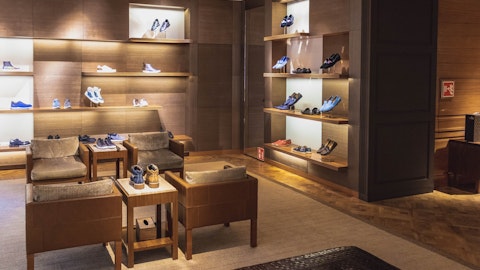Tom Nikic: Hey everyone, thanks for taking my question. Following up on Kelly’s question earlier about DTC, and I believe you said you’re more cautious on DTC now than you were three months ago. Can you give us any sort of, I guess, quantification or I guess previously you thought DTC would be up most of the digits for the year. How should we think about it for before or for the full year?
Edward Rosenfeld: Yes, thank you Tom, that’s a good question. So that’s right, our previous forecast we had built in about a 1% increase in DTC for the year, and we’ve now lowered that to down close to 4.5% for the year. So the bridge from that one to the close to down 4.5, you got about 150 basis point negative impact from the crisis in the Middle East and the impact that’s had on our bricks and mortar stores, on our DTC business rather in Israel, in our Israel JV and our Middle East JV. We’ve also got about a 50 basis point impact from non-comp stores, stores that we were planning to open that we have delayed the openings on. And then the balance, close to 350 basis points is due to a lower comp assumption because of this slowdown that we talked about, starting really in September.
Tom Nikic: Understood, and I’m not sure if you mentioned this earlier, but has there been any improvement in the DTC trend, quarter to date or with the cooler weather or anything like that?
Edward Rosenfeld: No, unfortunately, we talked about it being slow in September. October was even weaker than September, and November has really been in line with October.
Tom Nikic: Understood, all right, thanks Ed, and best of luck with all of these.
Edward Rosenfeld: Thanks, Tom.
Operator: One moment for our next question. Our next question comes from Laura Champine with Loop. Your line is open.
Laura Champine: Thanks for taking my question. I wanted to ask about the private label slowdown that happened in Q2. Did you get catch up sales from that in Q3, or was it just a return to normal wholesale volumes from private label customers in Q3?
Edward Rosenfeld: Good morning, Laura, thank you. So I wouldn’t say we had catch up sales from Q2, but private label did get much better in Q3. And that’s really a function of the comparisons from the prior year. So it was really Q3 of last year when we began to see that steep slowdown in private label as the big customers there cut orders to try to get their inventories back in line. So we were anniversarying much easier numbers beginning in Q3 and that’s why you saw that number get much, that business get much better on a year-over-year basis. We also did have between Q3 and Q4 a little bit of a shift from Q4 into Q3. So private label was up nicely in Q3, it will be down again in Q4, but for the back half it will be up in total.
Laura Champine: Understood. And then on the EPS guide towards the low end of your prior range, how much pricing are you giving? Because otherwise I think your gross margins be really strong in Q4.
Edward Rosenfeld: We built in a little bit more, we’ve assumed it particularly in DTC that it is a very promotional fourth quarter here. I think from here on out you’re going to see a lot of promotions across the industry. So we built a little bit of that into our guidance. But in wholesale I don’t really see us giving any price back. Any other colors, Zine?
Zine Mazouzi: Yes, no, as far as Q4, I think we were very clear with the guide that $2,040 for EPS, I might as well tell you that the gross margin will also be somewhere around 42%. And if you look at the 42%, it’s about 40 basis points or so lower than last year. And that’s primarily driven, we have a benefit from freight as we know, and we discussed it earlier for 100 basis points. And we have the offset of the mix of the business. And mix means the penetration of DTC, penetration of private label, and the addition of Almost Famous into the mix is 140 basis points the other way.
Laura Champine: Got it, that’s very helpful, thank you.
Zine Mazouzi: Thanks, Laura.
Operator: One moment for our next question. Our next question comes from Janine Stichter with BTIG. Your line is open.
Janine Stichter: Hey, good morning. Wanted to dig a little bit more into the slowdown that you’ve seen in September and beyond. It’s been pretty well documented across the industry, but just love your thoughts on what you think is driving that. And then it sounds like you’ve definitely seen it in your retail business. Curious if you have any sense of what’s happened in terms of sell throughs at wholesale and just your views on the inventory industry-wide, if any of the department stores have kind of been caught off guard by the slowdown and what inventories look like in the channel. Thank you.
Edward Rosenfeld: Sure. Yes, I think the first question, thank you, Janine. I think the first question was what’s driving the slowdown? Look, I think there’s a lot of macro data that we can point to about pressure on the consumer, whether it’s credit card debt or continued inflation or resumption of student loan payments, etcetera. I can’t tell you exactly what’s driving what we’re seeing, but I’m not sure that it matters. I think that what matters is it’s happening and we need to make sure that we manage our business accordingly. You asked about sell-throughs at wholesale. We have seen a similar impact in wholesale. When we speak to our wholesale customers, I think on a relative basis, we’re still doing well and better than our direct competitive set in terms of wholesale sell-throughs, even over the last couple months, but we have seen the rate slow down a bit.
And then in terms of inventory in the channel, I think that generally speaking, I still don’t think inventories are very out of whack in the channel, although there are certainly categories where there’s probably too much inventory. I mean, if you think about booths, for instance, I think the booty category has been weaker than expected and there’s probably some excess inventory building in the channel there.
Janine Stichter: Thanks a lot.
Edward Rosenfeld: Thank you.
Operator: One moment for our next question. Our next question comes from Corey Tarlowe with Jefferies. Your line is open.
Corey Tarlowe: Hi, good morning. Just to follow up on the Almost Famous acquisition, could you talk a little bit about what you think the longer term sales and margin opportunity for the acquisition could be as we think about the growth or the potential growth for that business ahead and if it’s perhaps ratable what that could look like. And then also you mentioned that you’ve controlled expenses and you’re driving cost efficiencies. Where are some other areas where you think you could fine tune the business to further optimize cost ahead?


